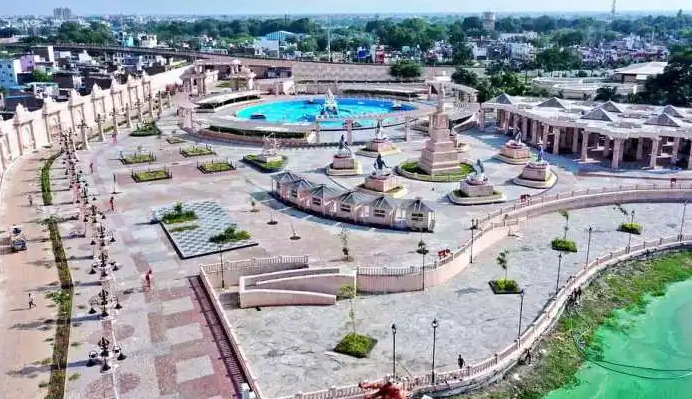
Mahakal Lok corridor: What is special about the temple and the project?
Not only is the Mahakal temple different from the other “jyotirlinga” sites, the city of Ujjain is quite significant, too

Prime Minister Narendra Modi is all set to inaugurate the first phase of the Shri Mahakal Lok corridor in Madhya Pradesh’s Ujjain today (Tuesday).
The Mahakal corridor, with a budget of Rs 850 crore, is four times the size of the Kashi Vishwanath corridor. Modi inaugurated the latter late last year. Mahakal temple is the third “jyotirlinga” after Varanasi’s Vishwanath temple and Uttarakhand’s Kedarnath shrine, to see a major uplift.
So, what is the significance of Ujjain’s Mahakal temple in Hinduism? Read on to know more.
The “jyotirlinga” site with a difference
According to the “Shiva Mahapurana,” Lord Shiva pierced the three worlds as a boundless pillar of light, called the “jyotirlinga.” The 12 “jyotirlinga” sites in India are where Shiva is believed to have appeared as the column of light.
Also read: This is India’s period of cultural resurrection: MP CM on Mahakal corridor
Besides Ujjain’s Mahakal, the sites include Rameshwar in Tamil Nadu, Mallikarjuna in Andhra Pradesh, Somnath and Nageshwar in Gujarat, Omkareshwar in Madhya Pradesh, Kedarnath in Uttarakhand, Viswanath at Varanasi, Baidyanath in Jharkhand, and Bhimashankar, Triyambakeshwar, and Grishneshwar in Maharashtra.
Mahakal is the only jyotirlinga facing south; the rest face east. That is because south is believed to be the direction of death. People worship Mahakaleshwar to prevent an untimely death.
The legends
A local legend says that a king called Chandrasena once ruled Ujjain. He was a devotee of Lord Shiva, who appeared in his Mahakal form and destroyed Chandrasena’s enemies. Upon his devotees’ request, Shiva agreed to live in the city and become its chief deity.
Also read: Much ado about eating beef; Ranbir, Alia stopped from visiting Mahakaleshwar temple in Ujjain
Several ancient Indian texts mentioned the Mahakal temple. Kalidasa described the Mahakal temple in “Purva Megha,” the first part of “Meghadutam” (4th century). He described it as a temple with a stone foundation, with the ceiling on wooden pillars. (There were no shikharas or spires on temples before the Gupta period.)
Ujjain is special, too
Ujjain was one of the primary learning centres of Hindu scriptures. It was known as Avantika in the sixth and seventh centuries BC. Later, astronomer-mathematicians such as Brahmagupta and Bhaskaracharya made Ujjain their home. That is because Ujjain is unique for astronomy.
According to the fourth-century text “Surya Siddhanta,” one of the earliest on Indian astronomy, the zero meridian of longitude and the Tropic of Cancer intersect where Ujjain is located. Hence, many of Ujjain’s temples are connected to time and space. The chief among them, the Mahakal temple, is dedicated to the lord of time.
Also read: Zomato apologises, withdraws Hrithik Roshan’s ‘Mahakal’ ad after backlash
In the 18th century, Maharaja Jai Singh II built an observatory in Ujjain, along with four others in Delhi, Jaipur, Mathura, and Varanasi. Comprising 13 architectural instruments to measure astronomical phenomena, these observatories are better known as Jantar Mantar or Vedh Shala.
In the 13th century, Turkish ruler Shams-ud-din Iltutmish destroyed the temple complex during a raid on Ujjain. In 1734, the Maratha general Ranoji Shinde built the current five-storeyed structure in the Bhumija, Chalukya, and Maratha styles of architecture. A century later, the Scindias restored its marble walkways.
The new project
The Mahakal Lok project promises to provide pilgrims with world-class amenities. The project aims to decongest the area with emphasis on the conservation and restoration of heritage structures.
Watch: Massive avalanche near Kedarnath temple
The Mahakal Path contains 108 stambhs (pillars) depicting Lord Shiva’s Anand Tandav Swaroop dance. Many religious sculptures depicting Lord Shiva’s life have been installed along the Mahakal Path. The mural wall along the path is based on Shiva Purana stories.
The central plaza, spread over 2.5 hectares, is surrounded by a lotus pond, and contains a statue of Shiva and fountains.
(With agency inputs)

